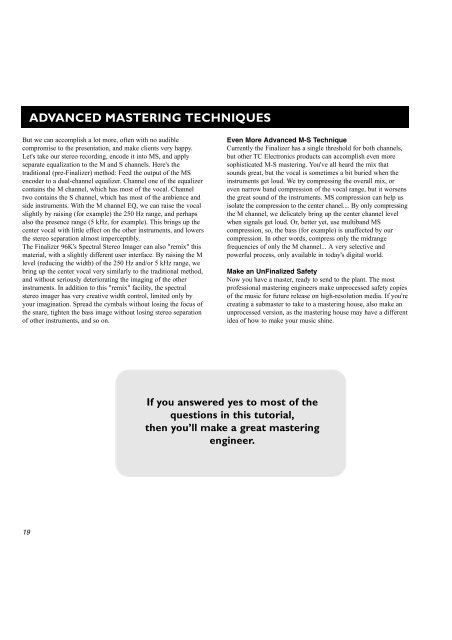2x4cdyD3b
2x4cdyD3b
2x4cdyD3b
Create successful ePaper yourself
Turn your PDF publications into a flip-book with our unique Google optimized e-Paper software.
ADVANCED MASTERING TECHNIQUES<br />
But we can accomplish a lot more, often with no audible<br />
compromise to the presentation, and make clients very happy.<br />
Let's take our stereo recording, encode it into MS, and apply<br />
separate equalization to the M and S channels. Here's the<br />
traditional (pre-Finalizer) method: Feed the output of the MS<br />
encoder to a dual-channel equalizer. Channel one of the equalizer<br />
contains the M channel, which has most of the vocal. Channel<br />
two contains the S channel, which has most of the ambience and<br />
side instruments. With the M channel EQ, we can raise the vocal<br />
slightly by raising (for example) the 250 Hz range, and perhaps<br />
also the presence range (5 kHz, for example). This brings up the<br />
center vocal with little effect on the other instruments, and lowers<br />
the stereo separation almost imperceptibly.<br />
The Finalizer 96K's Spectral Stereo Imager can also "remix" this<br />
material, with a slightly different user interface. By raising the M<br />
level (reducing the width) of the 250 Hz and/or 5 kHz range, we<br />
bring up the center vocal very similarly to the traditional method,<br />
and without seriously deteriorating the imaging of the other<br />
instruments. In addition to this "remix" facility, the spectral<br />
stereo imager has very creative width control, limited only by<br />
your imagination. Spread the cymbals without losing the focus of<br />
the snare, tighten the bass image without losing stereo separation<br />
of other instruments, and so on.<br />
Even More Advanced M-S Technique<br />
Currently the Finalizer has a single threshold for both channels,<br />
but other TC Electronics products can accomplish even more<br />
sophisticated M-S mastering. You've all heard the mix that<br />
sounds great, but the vocal is sometimes a bit buried when the<br />
instruments get loud. We try compressing the overall mix, or<br />
even narrow band compression of the vocal range, but it worsens<br />
the great sound of the instruments. MS compression can help us<br />
isolate the compression to the center chanel.... By only compressing<br />
the M channel, we delicately bring up the center channel level<br />
when signals get loud. Or, better yet, use multiband MS<br />
compression, so, the bass (for example) is unaffected by our<br />
compression. In other words, compress only the midrange<br />
frequencies of only the M channel... A very selective and<br />
powerful process, only available in today's digital world.<br />
Make an UnFinalized Safety<br />
Now you have a master, ready to send to the plant. The most<br />
professional mastering engineers make unprocessed safety copies<br />
of the music for future release on high-resolution media. If you're<br />
creating a submaster to take to a mastering house, also make an<br />
unprocessed version, as the mastering house may have a different<br />
idea of how to make your music shine.<br />
If you answered yes to most of the<br />
questions in this tutorial,<br />
then you’ll make a great mastering<br />
engineer.<br />
19


